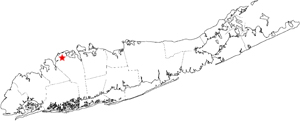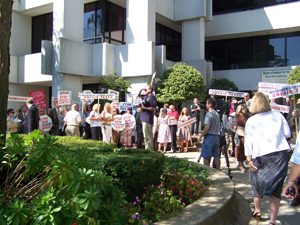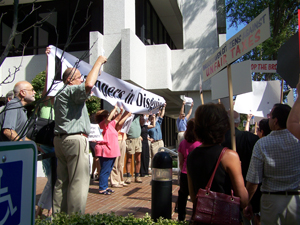 |
VISION LONG ISLAND SMARTTALK SEPTEMBER 2007 EDITION |
|
Register Today for the 2007 Smart Growth Summit
Join Vision Long Island for the 6th Annual Smart Growth Summit to be held on Friday, November 16th from 8:00am to 3:00pm at the Melville Marriott. This comprehensive land-use conference brings Long Island's leaders and experts together to address issues of Smart Growth and Livability. Workshop topics include: Transportation & Congestion Pricing, Clean Energy & Green Building, Sewers & Infrastructure, Codes & Regulations, Commercial Corridor Redevelopment, Community Planning & Public Process, Regional Planning, Housing & Gentrification, Downtown Revitalization, and Projects of Regional Significance. Sponsorships are available. Register today! Click here for the registration form.
|
|
Forum on Transportation Solutions for Long Island Announced For September 20th
The Hofstra Center for Suburban Studies, Long Island Community Foundation, Long Island Regional Planning Board, New York Community Trust, One Region Funders' Group, Rauch Foundation, Sustainable Long Island, Tri-State Transportation Campaign, and Vision Long Island are coming together to hold a forum, Transportation Solutions for Long Island: Towards Transit-Centered Community Development, on September 20th, 2007 from 9:00am to 11:30am at the Hofstra University Business Development Center, Axinn Library. Transportation is a major challenge for Long Island employers and their employees, and congestion a huge and growing problem for residents and workers alike. New leadership at the Metropolitan Transportation Authority (MTA) is looking at transportation solutions in fresh and creative ways, exploring opportunities to enhance service and improve stations, but also to invest in strategies that bring jobs and housing closer together, and reduce vehicle miles traveled. Long Island offers a laboratory for testing new ideas – such as transit-centered community development – borrowing a page from New Jersey’s highly successful Transit Village playbook. As community leaders look toward transit centers for development and congestion relief, it is essential that we develop solutions that serve people of all income levels, not just the most fortunate among us. Please join civic, nonprofit, and government leaders in a community forum for a discussion about the connections between job mobility, housing, economic development, congestion relief, and transportation investments, and the opportunities that new approaches and strategies could bring to Long Island.
Speakers for the event include: Mark Stout, Assistant Commissioner, New Jersey Department of Transportation; Elliot G. Sander, Executive Director & CEO, Metropolitan Transportation Authority. Respondents include: Connie Kepert, Councilwoman, Town of Brookhaven and Jack Martins, Mayor, Village of Mineola. The moderator is Joye Brown, Columnist, Newsday. Please RSVP to this invitation to the Long Island Community Foundation by leaving a phone message at 516-348-0575 x601, or by sending an email to responses@licf.org. For directions to the campus by car or public transportation, please click here. Long Island's Real Estate Next Conference to be Held September 27th
Real Estate Next will hold a conference, "How to Thrive in a Changing Market," on September 27th from 9:30am to 5:00pm at the Long Island Marriott Hotel & Conference Center in Uniondale. The 2nd annual conference will feature top real estate experts addressing the latest housing issues and opportunities for networking with industry decision-makers. Attendees can earn 5 continuing education credits. Speakers include Dottie Herman, president and chief executive officer of Prudential Douglas Elliman; appraiser Jonathan Miller of Miller Samuel Inc.; Tim Knight, publisher and chief executive officer of Newsday; David Peskin, president and chief executive officer, Mortgage Warehouse; Shawn Elliott, president of Shawn Elliott Luxury Homes & Estates; Denis Coleman, senior vice president of Optimum Homes; Ryan Slack, chief executive officer of Property Shark; Marc Spector, principal of The Spector Group; Joe Mottola, chief executive officer of the Long Island Board of Realtors.; Dr. Pearl Kamer, chief economist with the Long Island Association; Jim Morgo, Suffolk County Commissioner on Economic Development and Workforce Housing, Ron Stein, Vision Long Island, and many more. For the full conference line-up and instructions for registering online, visit www.realestatenext.net For more information, contact Ron Roel at roel@optonline.net or Laura Koss-Feder at kosfeder@optonline.net, or call the Real Estate Institute at 212-967-7508 to register by phone. The $95 registration fee includes all panels, breakfast, lunch, and a networking hour. US Green Building Council To Hold Seminar on Engineering & Design Principles for the Development of a Sustainable Village
The US Green Building Council will be holding a seminar, Engineering & Design Principles for the Development of a Sustainable Village, on September 19th, 2007 at 8am at the Sheraton Long Island Hotel at 110 Motor Parkway in Hauppauge. The Development of Smart Growth projects lends itself to the creation of sustainable communities by incorporating various design principles including New Urbanism and Green Design techniques. Based upon an actual Smart Growth project in the midst of a long term policy amendment and entitlement phase, the presentation will walk through the conceptual development of a 1600-home planned village community with a pedestrian-oriented town center and several villages comprised of a variety of housing types, with a mix of civic, office, and retail spaces. The project, known as Repaupo Village Center, is located in Logan Township, Gloucester County, New Jersey. The seminar offers 1.5 continuing education credits. Registration information is available here. It Takes a Village: Intergenerational Programs That Work Conference
Whether in the workplace or the communty in general, relationships among different generations are more important today than ever before. As life expenctancies continue to rise dramatically, generations depend on one another for much longer periods of time. Not only are middle-aged individuals providing shelter, food, clothing and education for those under 25, many of these same families are also caring for and providing support for relatives over age 75. While many young people are leaving Long Island in pursuit of affordable housing elsewhere, many older people are leaving for southern retirement communities or choosing to remain on the island, but moving into age-restricted communities. The unfortunate result is a separation of the generations. These circumstances pose real challenges to the normal balance, and urgently call for new and creative ways to encourage generational groups to communicate with one another, care for one another, and support public policies that don't divide them by age. It Takes a Village: Intergenerational Strategies That Work is designed to bring together Long Island's community organizations and its business community to create effective intergenerational programs and promote public policy that meets the needs of all generations. The conference takes place on Monday, November 12, 2007 from 9:00am to 4:00pm at the Charles B. Wang Center at Stony Brook University. Click here for a registration form, or visit Intergenerational Strategies' website here. |
|
Brookhaven Community Preservation Fund Referendum to be on Ballot in November Met With Strong Opinions on Both Sides of Issue
On Tuesday morning, two groups met at the steps of the Brookhaven Town Hall to engage in a bitter demonstration concerning future development in Suffolk County. The demonstration and counter-demonstration were instigated by Brookhaven Town Supervisor Brian X. Foley’s initiative to put a Community Preservation Fund on the ballot this November. Local civic leaders and environmental groups showed up at the town hall as a counter demonstration to show support for the CPF. They butted heads with many residents, developers, and real estate brokers who were in opposition to the CPF and the supposedly increased taxes it would create. According to Supervisor Foley and his supporters, the proposal would provide the next generation with the proper funding to preserve open spaces and limit the sprawling development that is plaguing other areas of Eastern Long Island. Members of the committee who drafted the proposal included ABCO members, the Pine Barrens Society, the League of Conservation Voters, the Nature Conservancy, members of the Long Island Builders Institute, the Long Island Association and many others. The press conference, held on Tuesday, September 04, 2007 at the steps of town hall, spoke out against the additional tax and the purported market slump that would result from limiting developable land. While the CPF proposal assesses a two percent fee on the purchase price of a home in excess of $250,000, no fee is paid unless a home’s cost is more than $250,000. In the Brookhaven Town CPF proposal, there is an exemption for first-time home buyers, who will pay no fee. The proposal encourages achieving the American dream of home ownership without encouraging sprawl or green-field development on former open space. In addition preserving the quality of life, the Town expects the CPF to provide between $30,000,000 and $33,000,000 annually over the 17-year course of the CPF. A CPF has been adopted into law in the five East End towns, where it has generated millions in open space funds. A unique part of the The Town of Brookhaven will be placing the referendum for a Community Preservation Fund for the town on the ballot this November. That means that CPF will only be implemented if a majority of voters approve the referendum. The funds from the tax will be used to preserve farmland, open space, drinking water recharge areas and critical wildlife habitat. This is a one-time tax on real estate that will be paid when purchasing vacant or developed property. The only people who will pay the tax are those who purchase property. The first $250,000 of the purchase price of a house or building ($150,000 for unimproved land) is exempt from the real estate transfer fee. In addition, income-qualified first-time homebuyers are exempt from paying the tax. The CPF is a dedicated fund, and may only be used for preservation and stewardship purposes. It is projected that the real estate transfer tax will raise at least $500 million before it ends in 2025, for the purchase of farmland, open space, and critical wildlife habitat to keep it from being developed or taken out of agricultural production. Passage of the CPF will allow the Town to leverage matching dollars from Federal, State, and County sources. This increases the purchasing power of CPF and maximizes the number of acres that can be purchased. CPF proposal in Brookhaven is the inclusion of a Transfer of Development Rights program. Under that proposal, one-quarter of the development rights generated in the purchase of an open space parcel would be transferred into a development rights bank and could be purchased by developers to increase density in other projects. Those development rights could be used for affordable housing, redevelopment projects in rebuilding downtown areas and other projects. Development rights could be used for nearly all zoning categories, such as residential, industrial and commercial. Vision Long Island supports the Brookhaven CPF as it is an important component of the Regional Blueprint for Smart Growth. For more information, visit the Lake Ronkonkoma Civic Organization's website. To read Newsday's editorial on the protest and the CPF, click here.
Canvas Magazine, a new and free publication for Long Islanders, recently published an article about congestion charging and the impact for Long Island and the surrounding region. Improved mass transportation, freight trains, hybrid cars, walkable communities, grid-like streets, alternative fuel—in addition to removing harmful pollution, they could help keep trucks and cars off over-congested roads while also keeping the remaining traffic moving. Put into effect, they would also enable us, collectively, to reduce our carbon footprint. Alternative transportation initiatives, of course, are not without controversy. Consider for a moment New York City Mayor Michael Bloomberg’s congestion-pricing proposal which aims to impose a fee on cars entering Manhattan below 86th St. on weekdays from 6 a.m. to 6 p.m. Though critics see it as nothing but a tax, Eric Alexander says the program is good for Long Island, too. “It impacts the entire region,” notes Alexander, executive director of Northport-based Vision Long Island, a non-profit that advocates smart-growth principles. The plan would lead to the “reduction of emissions” that contribute to climate change, he points out. And, the fees collected are expected to help provide funding to improve transit services including the Long Island Railroad Read the full text here. Sewer District in Nassau Pushes for Changes Under pressure to meet federal and state mandates to reduce nitrogen emissions to Long Island Sound, the Great Neck Water Pollution Control District has made the decision to upgrade its own plant with an oxidation ditch system, rejecting Nassau County's offer to take over the Great Neck plant and divert to the County plant at Cedar Creek. The new system would produce an effluent that is near drinking water quality and pure enough to meet the stringent Long Island Sound TMDL standards. Eventually, it may also enable some of the effluent to recharge into the ground, which could help stabilize the Peninsula's salt water intrusion problem that has resulted in wells being closed in Kings Point. The rest would be pure enough to be discharged into the Long Island Sound. Read the full article in the Great Neck News. Long Island Business News recently published an article about Nassau County Executive Tom Suozzi's stalled plans for consolidating Nassau's sewer districts. "Nassau County’s plan to reroute sewage from outdated North Shore wastewater plants to a newer South Shore plant has clogged, despite concerted efforts by County Executive Tom Suozzi. After meeting with officials and engineers on the proposal to extend the pipeline that leads to Wantagh’s Cedar Creek treatment facility, Suozzi was told that sewer districts in Great Neck and Port Washington have vetoed the plan, saying they’d rather spend the estimated $47 million needed to upgrade their systems than switch to county service." The full article is available online here. |
|
Kegger Time In Bradburn Village
Every Friday night, residents of the new urbanist community Bradburn Village in Westminster, Colorado gather for their weekly park party. Adults socialize over beer and wine while the kids play together. Bradburn is designed to encourage social interaction among neighbors, and judging by the packed park parties and the incredible number of social events here, it works. Read the full article on TreeHugger.com. Popular Omaha by Design Plan Gets Green Light from City Council With Omaha Community Foundation researchers finding eight years ago that Omahans want the city to be ''connected, smart, significant, sparkling and fun,'' its public-private Lively Omaha group and the national Project for Public Spaces (PPS) have jointly drawn up a long-range comprehensive Omaha by Design plan, whose public success inspired the group to assume that name, and now the City Council has affirmed the new urban course with a 7-0 vote for a landmark package of zoning code revisions and additions to make the public wishes come true. Under the code changes, reports Omaha World-Herald writer Karen Sloan, large retail buildings will have brick or stone facades, large windows and human-scale signs. Responsible Growth Task Force to Chart Smart Growth for Connecticut ''We are charting a new, anti-sprawl course for Connecticut,'' said Republican Governor M. Jodi Rell at the Windsor train station, near an old factory being converted into housing, as she signed a bill that establishes a Responsible Growth Task Force and gives it six months to submit guidelines for investment of bond dollars, state and federal grants and other public funds according to ''real'' economic planning, which ensures coordinated efforts of state agencies ''in the areas of transportation, housing, public health and work force development,'' with a Hartford Courant editorial calling it a good day for Smart Growth. Closely Connected Northwest Cities Need To Plan Together "In 1978, Oregon voters created Metro, still the only directly elected metropolitan planning organization in the United States. Its responsibilities include growth management, transportation planning and greenspace administration. We can't envisage three more critical, and more connected, responsibilities. Yet Metro's jurisdiction ends at the Columbia River. The result: Clark County, which still seems more adept at producing suburbs than salaries, continues to serve as the relief valve for the Oregon metropolis. That's why some 60,000 of its citizens commute to the Portland area each day, accounting for almost half the traffic crossing the Interstate Bridge." "This can't continue. The time has come for officials on both sides of the river to begin talking about Washington voters directly electing representatives to the Metro Council. Legislatures in Salem and Olympia need to craft a plan that could win quick approval from congressional delegations." Wisconsin Wants To Make Walking More Attractive To Students, Parents The state of Wisconsin has plans to use $4 million in federal transportation grants to encourage students to walk or bike to school. Much of the work will focus on improving road conditions to convince parents that walking or biking is safe. Smart Growth Incentive Enables Zoning Changes A Massachusetts smart growth incentive has enabled a Boston suburb to change its zoning laws to allow developers to build mixed-use developments without applying for special permits. Now other towns want in, but there might not be enough funding. "Developers who might want to build a mix of apartments and stores in Brockton's struggling downtown now can do so without getting any special zoning permits." "The city revamped its zoning this summer by approving a new district under Massachusetts General Law Chapter 40R, the state's three-year-old initiative aimed at promoting smart growth and affordable housing. The state promises cash to communities that use the law, and Brockton is now eligible for a $600,000 incentive grant." Chicago's Northwest Suburbs Working To Promote TODs Leaders of suburban cities and villages in northeastern Illinois are coming together to promote transit oriented development around commuter rail lines leading into Chicago. In Chicago's "northwest suburbs, when mayors and village managers attend regional planning seminars, they often hear the terms new urbanism, green urbanism, green buildings, functional neighborhoods, transit-oriented development and human-scale communities." Now they are trying to implement it, though planning resources can be limited. "In downtown Palatine, the Metra commuter train station on WestWood Street has created transit-oriented activity and commercial expansion, said Mayor Rita Mullins, co-chair of the Metropolitan Mayors Caucus Housing Committee." "We've built our downtown around the commuter station, and so have other towns up and down the (Union Pacific Northwest Rail) line leading into Chicago," she said. |
Special thanks to Smart Growth Online, Smart Growth America, Planetizen, KnowledgePlex, and the Urban Land Institute's (ULI's) Smart Growth News for their extraordinary news sweeps, which provide substantial content to our state and National News. Check them out!! For more information about Vision Long Island, please visit http://www.visionlongisland.org or contact us at: |





















